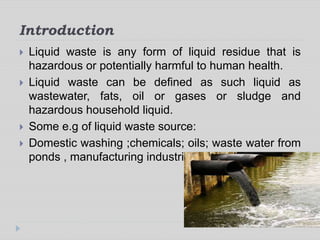All about Reclaim Waste
All about Reclaim Waste
Blog Article
What Does Reclaim Waste Do?
Table of ContentsSome Known Questions About Reclaim Waste.Some Ideas on Reclaim Waste You Need To KnowRumored Buzz on Reclaim WasteWhat Does Reclaim Waste Do?The Only Guide to Reclaim WasteReclaim Waste Fundamentals Explained

Never ever put harmful materials down sinks, bathrooms or stormwater drains Substances consisting of gas, oil, oil, chemicals and herbicides, and solvents such as paint pole dancers ought to not be put down sinks, toilets or stormwater drains. These compounds are hard to eliminate in the sewage therapy process and create contamination troubles in our regional waterways.

Although fluid waste is a term that covers a broad range of products, there's a good reason leaving its disposal to the specialists is recommended. Liquid waste is non-solid product that has no further usage and must be treated and disposed of according to neighborhood, state and federal guidelines.
Some Known Questions About Reclaim Waste.
Examples of liquid waste can consist of wastewater, fats, oils or oil, utilized oil, fluids, solids, gases or sludges and harmful house liquids, there are some that are taken into consideration to be a lot more harmful than others when it comes to the atmosphere and the wellness of pets and human beings alike. It's for this factor that each state and territory have actually stringent regulations connected to fluid waste monitoring.
Liquid waste can be stored in holding tanks or packaged in drums, intermediate mass containers or authorized small containers before either being dealt with or gotten rid of by means of outsourced vacuum vehicles. Offered the nature of the materials, fluid waste can not go in the general waste stream and there are strict regulations on just how to take care of it correctly.
(https://www.twitch.tv/reclaimwaste1/about)Depending upon a resolution of the degree of threat, it might be essential to remediate those sites. Additionally, unsafe fluid chemical wastes are controlled waste and needs to be tracked according to the state waste regulation. Under the chain of custodianship and obligations, owners are liable and responsible for waste produced by an organization.
One of the core applications for superabsorbent polymers (SAPs) is fluid waste solidification. liquid waste removal. SAPs are made use of by waste monitoring experts to avoid possibly hazardous fluids from entering waterways, groundwater aquifers, and various other sensitive atmospheres. Because fluids can rapidly deliver contaminants into environmental receptors and potentially add to geotechnical failings, fluid wastes are virtually always banned from disposal in garbage dumps
Things about Reclaim Waste
Essentially, totally free fluids are liquids that separate from the strong section of waste product. Fluid waste can consist of the following: HDD mud and cuttings Garbage dump leachate Wastewater treatment sludge & biosolids Dredged sediments Oil and gas drill cuttings Clearing up fish pond muck Hydro Excavation slurry Coal burning residuals/ash Container base sludge Concrete grinding/polishing slurry Related Write-up: For a practical example of free liquids separating from waste material, consider the following scenario: A waste management contractor loads a dump truck with sludge from a wastewater treatment plant's oygenation basin, during a routine maintenance event.
When the vehicle driver arrives at the garbage dump, he notifications water seeping from the sludge and pouring from the dump truck. The lots was rejected by the landfill and the vehicle driver was required to dispose of the waste as a liquid waste at a special center, which boosted the disposal charges enormously.
We also need to be responsible for the correct disposal of our waste materials. It is not sufficient that we pay waste disposal business to take care of our rubbish.
Some Known Details About Reclaim Waste

Segregating your waste can start inside the home. Set apart dry and fluid waste as well as edible waste, naturally degradable and non-biodegradable materials.
You can make use of old trash can, bucket, garden pot or old plastic drums. Pierce four to five openings in the container so the air can distribute. Layer the bottom with dirt to absorb the damp waste. Begin the composting process. Layer the garden compost with wet and completely dry waste along with dirt to maintain a balance in between the damp and the completely dry.
Fascination About Reclaim Waste
To help with faster disintegration, you can also add semi composted dirt to the compost. If you discover the scent is ending up being as well strong, include extra newspapers and paper waste or include more holes to the compost container to keep the balance of the waste products.
We additionally require to be accountable for the correct disposal of our waste materials. It is not enough that we pay waste disposal companies to take care of our rubbish.
Our waste, our duty. Have you ever questioned what takes place to your liquid waste after it's gathered? Did you know that liquid waste can be recycled?
What Does Reclaim Waste Mean?
Segregating your waste can start inside the home. Set apart completely dry and fluid waste as well as edible waste, naturally degradable and non-biodegradable materials.
You can utilize old trash can, bucket, garden pot or old plastic drums. Drill four to five openings in the container so the air can flow. Layer the base next with dirt to absorb the damp waste. Beginning the composting procedure. Layer the garden compost with damp and completely dry waste as well as dirt to maintain an equilibrium between the wet and the dry.
To facilitate faster decomposition, you can additionally include semi composted dirt to the compost. If you notice the odor is coming to be too solid, add extra papers and paper waste or include more openings to the compost container to keep the balance of the waste products.
Report this page